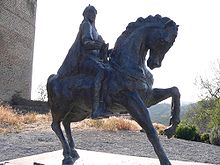Taifa of Mértola
Taifa of Mértola | |||||||||||
|---|---|---|---|---|---|---|---|---|---|---|---|
| 1033–1151 | |||||||||||
 Taifa Kingdom of Mértola, c. 1037. | |||||||||||
| Capital | Mértola | ||||||||||
| Common languages | Arabic, Mozarabic, Hebrew | ||||||||||
| Religion | Islam, Christianity (Roman Catholicism), Judaism | ||||||||||
| Government | Monarchy | ||||||||||
| Historical era | Middle Ages | ||||||||||
• Downfall of Caliphate of Córdoba | 1033 | ||||||||||
• To Seville/Almoravids | 1044–1091 / 1091–1144 | ||||||||||
• To Badajoz | 1145–1146 | ||||||||||
• Conquered by the Almohads | 1151 | ||||||||||
| Currency | Dirham and Dinar | ||||||||||
| |||||||||||
| Today part of | Portugal | ||||||||||

The Taifa of Mértola (Arabic: طائفة مارتلة) was a medieval Islamic Moorish taifa that existed in what is now southeastern Portugal. It existed during three distinct periods: from 1033 to 1044, from 1144 to 1145, and from 1146 to 1151. From 1044 until 1091 it was under the forcible control of the Taifa of Seville, by Abbad II al-Mu'tadid.[1] Its short-lived history ended in 1151, when it was finally conquered by the Almohad Caliphate.
List of Emirs
- Abbad II al-Mu'tadid:1033-1044[2]
Almoravid dynasty
- To Almoravid dynasty: 1091–1144
Qasid dynasty
- Abu-l-Qasim Ahmad ibn al-Husayn ibn Qasi: 1144–1145, d. 1151
- To Badajoz: 1145–1146
- Abu-l-Qasim Ahmad ibn al-Husayn ibn Qasi (restored): 1146–1151
- To Almohads: 1151–1250
References
See also